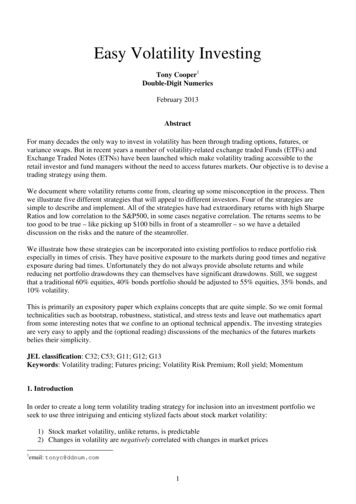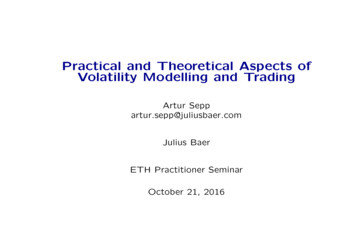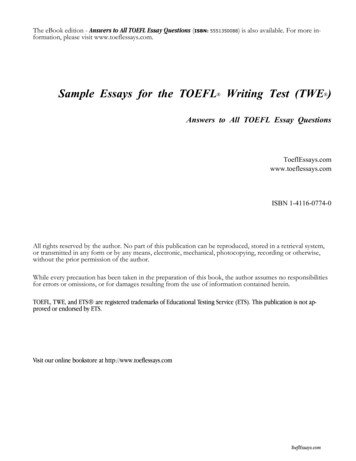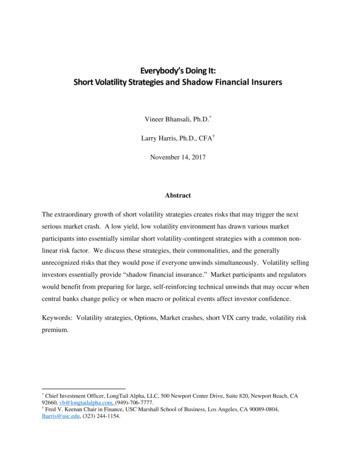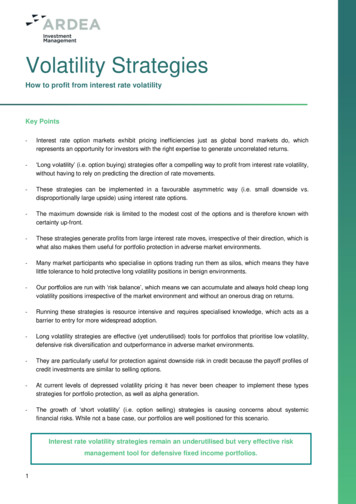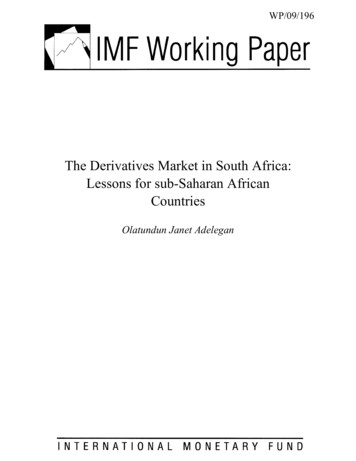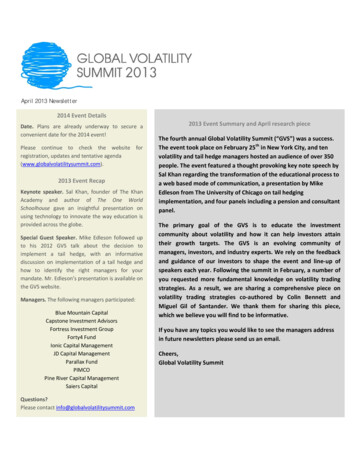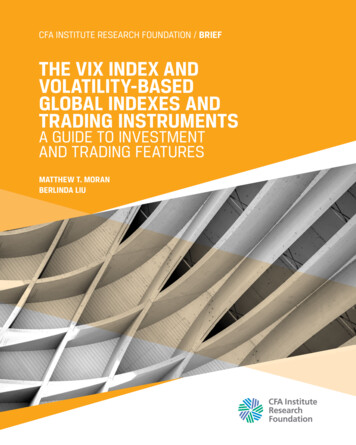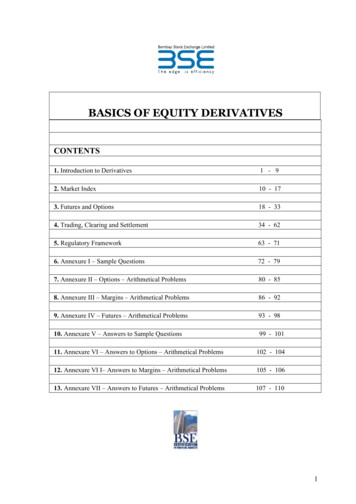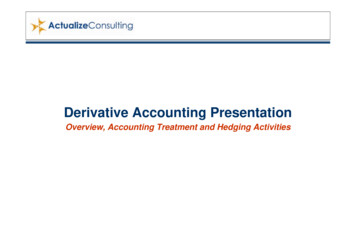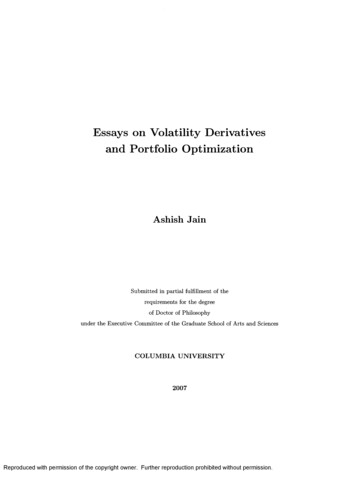
Transcription
E ssays on V o la tility D erivativesand P ortfolio O p tim izationA sh ish JainSubmitted in partial fulfillment of therequirements for the degreeof Doctor of Philosophyunder the Executive Committee of the Graduate School of Arts and SciencesC O L U M B IA U N IV E R S IT Y2007R ep ro d u ced with p erm ission o f th e copyright ow ner. Further reproduction prohibited w ithout perm ission.
UMI Number: 3285095INFORMATION TO USERSThe quality of this reproduction is dependent upon the quality of the copysubmitted. Broken or indistinct print, colored or poor quality illustrations andphotographs, print bleed-through, substandard margins, and improperalignment can adversely affect reproduction.In the unlikely event that the author did not send a complete manuscriptand there are missing pages, these will be noted. Also, if unauthorizedcopyright material had to be removed, a note will indicate the deletion. UMIUMI Microform 3285095Copyright 2007 by ProQuest Information and Learning Company.All rights reserved. This microform edition is protected againstunauthorized copying under Title 17, United States Code.ProQuest Information and Learning Company300 North Zeeb RoadP.O. Box 1346Ann Arbor, Ml 48106-1346R ep ro d u ced with p erm ission o f th e copyright ow ner. Further reproduction prohibited w ithout perm ission.
2007Ashish JainAll Rights ReservedR ep ro d u ced with p erm ission o f th e copyright ow ner. Further reproduction prohibited w ithout perm ission.
ABSTRACTEssays on Volatility Derivatives and Portfolio OptimizationAshish JainThis thesis is a collection of four papers: 1) Discrete and continuously sampled volatil ity and variance swaps, 2) Pricing and hedging of volatility derivatives, 3) VIX index andVIX futures, and 4)Asset allocation and generalized buy and hold trading strategies.The first three papers answer various questions relating to the volatility derivatives.Volatility derivatives are securities whose payoff depends on the realized variance of anunderlying asset or an index. These include variance swaps, volatility swaps and vari ance options. All of these derivatives are trading in over-the-counter market. W ith thepopularity of these products and increasing demand of these OTC products, the ChicagoBoard of Options Exchange (CBOE) changed the definition of VIX index and launchedVIX futures on VIX index. The new definition of VIX index approximates the one monthvariance swap rate. In second chapter we investigate the effect of discrete sampling andasset price jumps on fair variance swap strikes. We calculate the fair discrete volatilitystrike and the fair discrete variance strike in different models of the underlying evolu tion of the asset price: the Black-Scholes model, the Heston stochastic volatility model,the Merton jump-diffusion model and the Bates and Scott stochastic volatility modelwith jumps. We determine fair discrete and continuous variance strikes analytically andfair discrete and continuous volatility strikes using simulation and variance reductiontechniques and numerical integration techniques in all models. Numerical results areprovided to show that the well known convexity correction formula doesn’t work well toR ep ro d u ced with p erm ission o f th e copyright ow ner. Further reproduction prohibited w ithout perm ission.
approximate volatility strikes in the jump-diffusion models. We find that, for realisticcontract specifications and realistic risk-neutral asset price processes, the effect of dis crete sampling in minimal while the effect of jumps can be significant.In the third chapter we present pricing and hedging of variance swaps and other volatilityderivatives, e.g., volatility swaps and variance options, in the Heston stochastic volatil ity model using partial differential equation techniques. We formulate an optimizationproblem to determine the number of options required to best hedge a variance swap. Wepropose a method to dynamically hedge volatility derivatives using variance swaps anda finite number of European call and put options.In the fourth chapter we study the pricing of VIX futures in the Heston stochastic volatil ity (SV) model and the Bates and Scott stochastic volatility with jumps (SVJ) model.We provide formulas to price VIX futures under the SV and SVJ models. We discuss theproperties of these models in fitting VIX futures prices using market VIX futures dataand SPX options data. We empirically investigate profit and loss of strategies whichinvest in variance swaps and VIX futures empirically using historical data of the SPXindex level, VIX index level and VIX futures data. We compare the empirical resultswith theoretical predictions from the SV and SVJ model.In fifth chapter we present the generalized buy-and-hold (GBH) portfolio strategies whichare defined to be the class of strategies where the terminal wealth is a function of onlythe terminal security prices. We solve for the optimal GBH strategy when security pricesfollow a multi-dimensional diffusion process and when markets are incomplete. Usingrecently developed duality techniques, we compare the optimal GBH portfolio to theR ep ro d u ced with p erm ission o f th e copyright ow ner. Further reproduction prohibited w ithout perm ission.
optimal dynamic trading strategy. While the optimal dynamic strategy often signifi cantly outperforms the GBH strategy, this is not true in general. In particular, whenno-borrowing or no-short sales constraints are imposed on dynamic trading strategies, itis possible for the optimal GBH strategy to significantly outperform the optimal dynamictrading strategy. For the class of security price dynamics under consideration, we alsoobtain a closed-form solution for the terminal wealth and expected utility of the classicconstant proportion trading strategy and conclude that this strategy is inferior to theoptimal GBH strategy.R ep ro d u ced with p erm ission o f th e copyright ow ner. Further reproduction prohibited w ithout perm ission.
C ontents1 In tr o d u c tio n211.1 Volatility D erivatives.11.2 Asset Allocation and GeneralizedBuy-and-Hold Strategies.4E ffect o f J u m p s and D isc r e te S am p lin g on V o la tility an d V arian ceS w ap s72.1 Introduction.72.2 Volatility D erivatives.132.2.1Variance s w a p s .132.2.2Volatility sw aps.182.2.3Convexity correction f o r m u la .192.3 Black-Scholes M o d e l.232.3.1Black-Scholes Model: Discrete VarianceStrike.232.3.2Black-Scholes Model: Discrete Volatility S t r i k e .272.4 Heston Stochastic VolatilityM o d e l.282.4.1SV Model: Continuous Variance S trik e.292.4.2SV Model: Discrete Variance Strike31.iR ep ro d u ced with p erm ission o f th e copyright ow ner. Further reproduction prohibited w ithout perm ission.
2.5 Merton Jump-Diffusion M odel.2.5.1Jump-Diffusion Model: Continuous Volatility S t r i k e .332.5.2Merton Jump-Diffusion Model: DiscreteVarianceS tr ik e .352.5.3Merton Jump-Diffusion Model: Discrete VolatilityS trik e.372.6 Stochastic Volatility Model with J u m p s .392.6.1SVJ Model: Continuous Volatility S trik e .402.6.2SVJ Model: Discrete Variance S trik e .412.7 Numerical R e s u l t s .422.7.1Merton Jump-Diffusion Model.432.7.2Heston Stochastic Volatility M o d e l.482.7.3Stochastic Volatility Model with J u m p s .512.8 Conclusion332.60P ric in g and H ed g in g V o la tility D e riv a tiv es613.1 Introduction.613.2 Volatility Derivatives64.3.3 Pricing Volatility Derivatives.683.3.1Pricing Volatility S w a p s .683.3.2Pricing Variance Options.743.4 Risk Management Parameters ofVolatility D erivatives.763.4.1Delta of Volatility D erivatives.773.4.2Volatility Derivatives: k .793.4.3Volatility Derivatives: 6 .ii81R ep ro d u ced with p erm ission o f th e copyright ow ner. Further reproduction prohibited w ithout perm ission.
3.53.6453.4.4 Volatility Derivatives: & .83Hedging Volatility D erivatives.853.5.1 Replicating Variance S w a p s .853.5.2 Hedging Volatility Derivatives in the SV M o d e l.98Conclusion.103V IX In d e x an d V I X F u tu res1044.1Introduction.1044.2VIX Replication from SPX Options4.3Pricing VIX F u t u r e s . 1144.4Empirical Testing of Futures P ric e s . 1274.5Realized Volatility, Implied Volatility and VIX Index4.6Conclusion.106.129. 138A ss e t A llo c a tio n an d G en eralized B u y -a n d -H o ld S tr a te g ie s1415.1Introduction. 1415.2Problem Formulation and Trading Strategies.1475.2.1 The Portfolio Optimization P ro b le m .1475.2.2 The Static Trading S trateg y . 1515.2.3 The Myopic Trading S tra te g y . 1545.2.4 The Generalized Buy and Hold(GBH) Trading S tra te g y . 1555.3Review of Duality Theory and Construction of Upper B o u n d s.1585.4Numerical Results.163iiiR ep ro d u ced with p erm ission o f th e copyright ow ner. Further reproduction prohibited w ithout perm ission.
A5.4.1Incomplete Markets5.4.2No Short-Sales and No Borrowing Constraints5.4.3No Short-Sales C o n s tra in ts . 168Optimizing the Upper B o u n d .1695.6Conclusions and Further Research.172P ro o fs for C h a p ter 2184Proof of Proposition 5 . 184A.2 Proof of Proposition 10C.1685.5A .lB.167. 190P r o o fs for C h a p ter 4193B .lVIX Index-Log C o n tra c t. 193B.2Historical VIX Levels.195P ro o fs for C h a p ter 5C .l197The Static Strategy and Proof of Proposition 16 . 197C.2 Generalized Buy and Hold Strategy and ValueF u n c tio n . 198ivR ep ro d u ced with p erm ission o f the copyright ow ner. Further reproduction prohibited w ithout perm ission.
List o f Figures2.1Convergence of fair strikes with sampling size in jump-diffusion model. This figure plotson log-log scale difference in the fair discrete strike and the fair continuous strike versusthe number of sampling dates.2 .245Convergence of fair strikes with number of sampling dates in stochastic volatility model.This figure plots on log-log scale the difference in the fair discrete strike and the faircontinuous strike versus the number of sampling dates.2 .350Convergence of fair strikes with sampling size in SVJ model. This figure plots on log-log scale difference in the fair discrete strike and the fair continuous strike versus thenumber of sampling dates.3.152The left plot shows the square root of the fair variance strike and fair volatility strikeversus initial volatility. The right plot shows the convexity value (3.2.10) versus initialvolatility.3 .273The left plot shows the sensitivity of fair variance strike (3.4.3) and fair volatility strikew ith in itia l varian ce versu s in itia l volatility. T h e right p lo t sh ow s t h e d ifferen ce in th edelta of fair variance strike and fair volatility strike.vR ep ro d u ced with p erm ission o f th e copyright ow ner. Further reproduction prohibited w ithout perm ission.77
3 .3The left plot shows the sensitivity k of fair variance strike (3.4.9) and fair volatilitystrike (3.4.6) with mean reversion speed k versus initial volatility. The right plot showsthe difference between the two sensitivities.3 .480The left plot shows the sensitivity 6 of fair variance strike (3.4.15) and fair volatilitystrike (3.4.12) with long run mean variance 6 (3.4.10) versus initial volatility. The rightplot shows the difference between the two sensitivities.3 .582The left plot shows the sensitivity crv of fair variance strike and fair volatility strikewith volatility of variance a v (3.4.16) versus initial volatility. The right plot shows thedifference between the two sensitivities.3 .684Replication error in log contract with number of options. These figures show errormeasures defined in (3.5.8) and (3.5.9) in replicating portfolio to replicate a log contractwith finite number of options in the Black-Scholes model and the stochastic volatilitymodel. These figures are plotted on a log-log scale. These errors are computed for aninterval of one year.3 .791Replication error in a variance swap with number of options. These figures show errormeasures defined in (3.5.8) and (3.5.9) in replicating portfolio to replicate a varianceswap with a finite number of options in the Black-Scholes model and the stochasticvolatility model. The error measures are computed for an interval of one year for acontinuous variance swap where rebalancing is done continuously. These figures axeplotted on a log-log scale.viR ep ro d u ced with p erm ission o f th e copyright ow ner. Further reproduction prohibited w ithout perm ission.92
3 .8This figure shows the payoff of portfolio B (3.5.6, ‘true payoff’), payoff of portfolio A(3.5.7, ‘options portfolio A payoff’) and payoff of portfolio D (3.5.12, ‘options portfolioD payoff’) versus terminal stock price when there are four puts and four calls in optionsportfolio.The right plot shows the difference in portfolio payoffs (portfolio A andportfolio D ) from true payoff.4 .1The left table shows the effect of discrete strikes in computing the VIX index level. Thefirst column shows the strike interval in computing the VIX level and second columnshows the theoretical VIX level given by equation (4.2.2). These results are obtainedusing option prices from the SVJ model with parameters from column four in Table4.3. The right figure shows the plot of the VIX level versus strike interval.4 .2The left table shows the effect of a finite range of strikes in computing the VIX in dex level. The first column shows the factor x which defines strike range as K min S P X / x , Kmax x ( S P X ) in computing the VIX level. These results are obtained usingoption prices from the SVJ model with parameters from column four in Table 4.3. Theright figure shows the plot of the VIX level versus strike range.4 .3This figure shows the VIX futures price with maturity for two different value of initialvariance, Vt The left plot shows prices when initial variance, v t is less than 0. For thiscase we use all the parameters in Table 4.1. The right plot shows futures prices wheninitial variance, Vt is more than 0. In this case we use all the parameters in Table 4.1except Vt which is equal to 0.025 and hence vt 0.R ep ro d u ced with p erm ission o f th e copyright ow ner. Further reproduction prohibited w ithout perm ission.
4 .4This figure shows the (1 - p(excess probability ) (4.3.18)) with maturity for two differentvalue of initial variance,Vt.The left plot shows probability when initial variance,Vtisless than 9 . For this case we use all the parameters in Table 4.1. The right plot showsthe probability when initial variance, vt is more than 0. In this case we use all theparameters in Table 4.1 except vt which is equal to 0.025 and hence vt 6. 1254 .5This figure shows the smile implied by model and market implied smile. The upper leftplot shows the smile implied by the SV model parameters (obtained by minimizing meansquared error between prices) and market implied smile for three different maturitiesT1 23 days, T2 58 days and T3 86 days of options available on March 23, 2005.The upper right plot shows the smile implied by the SV model parameters (obtainedby minimizing mean squared error between volatilities) and market implied smile. Thebottom plot shows the same for the SVJ model. 1264 .6This figure shows the VIX index level historical series and one month realized volatilityfrom 1990-2006. 1334 .7These figures show the historical and theoretical (from SVJ model) monthly returnsfrom a short position in4 .8month variance swaps.136These figures show the historical and theoretical (from SVJ model) monthly returnsfrom a short position inB .loneonemonth VIX futures contracts.138T h e left p lo t sh o w s th e V IX tim e series from Jan u ary 2004 to Ju ly 2005. It sh o w s V IXm ark et series and V IX co m p u ted from our o p tio n s d a ta se t and th e ir differences. T h erigh t p lo t sh ow s th e h istogram o f d ifferen ces for t h e sam e tim e p erio d .196viiiR ep ro d u ced with p erm ission o f th e copyright ow ner. Further reproduction prohibited w ithout perm ission.
List o f Tables2.1 Model parameters used in numerical ex p erim en ts.432.2 Fair variance strikes and fair volatility strikes versus the number of sam pling dates in the Merton jump-diffusion model.432.3 Approximation of the fair volatility strike using the convexity correctionformula in jump-diffusion model.472.4 Fair variance strikes and fair volatility strikes with different numbers ofsampling dates in the SV m o d el.492.5 Fair variance strikes and fair volatility strikes with different numbers ofsampling dates in the SVJ m o d e l.522.6 Approximation of the fair volatility strike using the convexity correctionformula in SVJ m o d e l .532.7 Comparison of fair variance strikes and fair volatility strikes in differentmodels.552.8 Comparison of fair variance strikes with an alternative definition of real ized variance and with maturities in the SVJ model.562.9 Comparison of fair volatility strikes and approximations using the convex ity correction formula in different models.ixR ep ro d u ced with p erm ission o f th e copyright ow ner. Further reproduction prohibited w ithout perm ission.57
2.10 Effect of jumps in the fair variance strike.593.1 Black-Scholes and stochastic volatility model parameters used in pricingand hedging.713.2 Comparison of fair variance and fair volatility strikes using different nu merical methods.733.3 Prices of variance call and put options in the Heston stochastic volatilitym o d e l .763.4 Error in static replication of log contract with a finite number of options .903.5 Error in dynamic replication of variance swap with a finite number ofoptio n s.923.6 Error in dynamic replication of a discrete variance swap with a finitenumber of options.943.7 Number of call and put options in replicating a variance swap with fourcall and four put o p tio n s.963.8 Comparison of errors in dynamic replication of a discrete variance swapwith a finite number of option portfolios A and D.973.9 Historical performance of options portfolio A and options portfolio D inreplicating a discrete variance swap.983.10 Hedging volatility swap using variance swaps and a finite number of op tions. 1014.1 Model (SV and SVJ) parameters used in pricing VIX Futures. 123xR ep ro d u ced with p erm ission o f th e copyright ow ner. Further reproduction prohibited w ithout perm ission.
4.2 Pricing of VIX Futures in the SV and SVJ models using different methods 1234.3 Model parameters obtained using empirical fitting.1254.4 Futures prices from different model parameters obtained using empiricalf i t t i n g . 1264.5 Descriptive statistics of historical VIX index level and one month realizedv o latility . 1324.6 Mean and standard deviation of yearly VIX index level and one monthrealized volatility and at-the-money implied v o la tility . 1344.7 Empirical and theoretical monthly returns from investing in variance swaps 1364.8 Monthly returns from investing in VIX futures. 1385.1 Calibrated model p a ra m e te rs .1755.2 Lower and upper bounds in incomplete markets - 1. 1765.3 Lower and upper bounds in incomplete markets - II.1775.4 Lower and upper bounds in no short sales and no borrowing case. 1785.5 Lower and upper bounds in no short sales case. 179B .l Difference between VIX Market and VIX from our options data.195xiR ep ro d u ced with p erm ission o f th e copyright ow ner. Further reproduction prohibited w ithout perm ission.
ACKNOWLEDGEMENTSI would like to express my sincere gratitude to my advisor, Professor Mark Broadie forhis guidance, encouragement and support in every stage of my graduate study. W ithouthis support and guidance this dissertation would not have been completed. I have learntfrom him in all ways: as a student in his classes, as his teaching assistant and his PhDstudent. Mark has been a great source of inspiration throughout my years at ColumbiaBusiness School. I am grateful for his wisdom, help in my education career and beyond.Another person who has been an invaluable source of help is Martin Haugh. I havegained so much through the courses he taught and our discussions over last couple ofyears. I am extremely grateful to him for his invaluable ideas which formed a major partof the last chapter of this thesis.I would like to thank Professor Paul Glasserman and Prof. Emanuel Derman forserving on my proposal defense committee and Prof. Suresh Sundaresan for serving onmy dissertation defense committee and for their valuable comments and suggestions onthe dissertation drafts. I thank all my fellow doctoral candidates and numerous professorswith whom I have taken courses and attended seminars.I further want to express my gratitude to my parents, who always supported me. Idedicate this dissertation to my parents.xiiR ep ro d u ced with p erm ission o f th e copyright ow ner. Further reproduction prohibited w ithout perm ission.
To M y P a re n tsxiiiR ep ro d u ced with p erm ission o f th e copyright ow ner. Further reproduction prohibited w ithout perm ission.
1C hapter 1IntroductionThis thesis develops pricing and hedging formulas for volatility derivatives, e.g., varianceswaps, volatility swaps, variance options, VIX futures, in different asset pricing modelswhich include stochastic volatility and jumps. The last chapter of this thesis developsnew class of trading strategies, the generalized buy-and-hold (GBH) portfolio strategiesin an incomplete market setting and compares the utility of these strategies with theoptimal dynamic trading strategy using duality techniques.In this chapter we give a brief motivation for the following chapters. Section 1.1 gives abrief overview of the chapters on volatility derivatives and section 1.2 gives an overviewof last chapter on asset allocation and generalized buy and hold trading strategies.1.1V o la tility D e r iv a tiv e sVolatility and variance swaps are forward contracts in which one counterparty agrees topay the other a notional amount times the difference between a fixed level and a realizedlevel of variance and volatility, respectively. The fixed level is called the variance strikefor variance swaps and the volatility strike for volatility swaps. This is typically setinitially so th at the net present value of the p
Essays on Volatility Derivatives and Portfolio Optimization Ashish Jain This thesis is a collection of four papers: 1) Discrete and continuously sampled volatil ity and variance swaps, 2) Pricing and hedging of volatility derivatives, 3) VIX index and VIX futures, and 4)Asset allocation and gene
